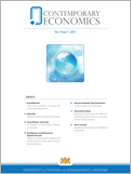Modeling Dynamic Causalities between the Indonesian Rupiah and Forex Markets of ASEAN, Japan and Europe
Modeling Dynamic Causalities between the Indonesian Rupiah and Forex Markets of ASEAN, Japan and Europe
Author(s): Hizir Sofyan, M. Shabri Abd Majid, Moh. Rizky RahmandaSubject(s): Business Economy / Management, Financial Markets
Published by: VIZJA University
Keywords: Integration; Granger causality; Forex trading benefits; Forex markets; ASEAN
Summary/Abstract: Historically, the Indonesian Rupiah (IDR) has fluctuated throughout the years, and its fluctuations have been very much interrelated with other forex markets. Since the IDR fluctuations impact national economic growth, investigating the movements of forex markets with respect to the IDR provides important policy implications. Due to limited previous studies investigating the interactions between the IDR and forex markets, this study explores the dynamic causality over both the short and long run between the IDR and the forex markets of ASEAN (Association of South East Asian Nations), Japan and Europe. The study utilizes the daily nominal exchange rates of Indonesia, Thailand, Malaysia, Singapore, the Philippines, Japan, the U.S., and Europe spanning from January 1, 2008, to December 31, 2015. These data were then analyzed using the cointegration and vector error correction (VECM) techniques. The study found that the IDR was cointegrated with the forex markets of ASEAN, Japan, and Europe. The IDR was found to be the most dependent market compared to the other ASEAN forex markets since those forex markets appeared to have close causal linkages between them. For multivariate causalities, the Philippine Peso was found to be the only forex market that was independent of both the Japanese and European forex markets. Additionally, the ASEAN forex markets were more influenced by the forex markets of Japan rather than those of Europe. Since the forex markets become more integrated regionally, there is a need for policy synchronization among those countries in order to manage the impacts of forex fluctuations.
Journal: Contemporary Economics
- Issue Year: 13/2019
- Issue No: 1
- Page Range: 35-48
- Page Count: 14
- Language: English

